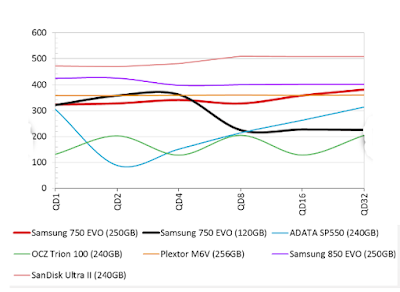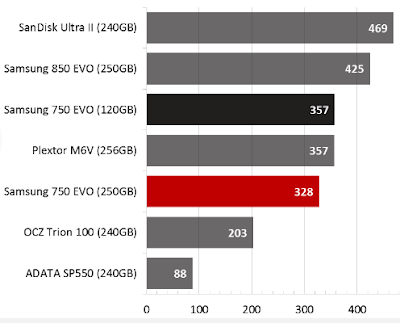Samsung's 840 EVO arrived with great fanfare and generated a lot of excitement, becoming the best-selling SSD of all time. Over time though, a problem emerged. Customers found that older data on the drives would read back much slower than fresh data. Samsung fired back with a pair of firmware upgrades and we haven't heard much of the issue since then.
Although it was never officially mentioned, we suspect the underlying issue had to do with the 840 EVO's error correction engine. Samsung recently told us that the 840 EVO used BCH ECC technology, similar to many other SSDs with MLC flash. Newer drives with TLC NAND employ a technology called LDPC (low-density parity-check), which is a much stronger form of error correction that uses both hardware and software checks to recover bit errors.
The new SSD 750 EVO uses the 850 EVO's controller equipped with the more advanced LDPC ECC engine. The SSD was introduced in Japan and other Asian markets two months ago. We assumed the 750 EVO was Samsung's way of burning through a stockpile of planar (2D) NAND before transitioning to 48-layer 3D flash. The company recently stated that planar flash still has a future, and will not disappear from its line-up anytime soon. Samsung's 2D NAND is manufactured using 16nm lithography, and we've heard rumors of a 14nm node in development.
The 750 EVO also crams a 256MB DDR3 memory module in the same package as the MGX controller, which should reduce latency between the processor and its DRAM buffer. This is the first time we've seen the advanced design in a Samsung SSD.
Specifications
|
Products
|
Samsung 750 EVO
(250 GB)
|
Samsung 750 EVO
(120 GB)
|
|
Form
Factor
|
2.5-inch.
|
2.5-inch.
|
|
Controller
|
Samsung MGX
|
Samsung MGX
|
|
DRAM
Buffer
|
256 MB DDR3
|
256 MB DDR3
|
|
NAND
|
Samsung 16nm TLC
|
Samsung 16nm TLC
|
|
Sequential
Read
|
540 MB/s
|
540 MB/s
|
|
Sequential
Write
|
520 MB/s
|
520 MB/s
|
|
Random
Read (QD1)
|
Up to 10,000 IOPS
|
Up to 10,000 IOPS
|
|
Random
Read (QD32)
|
Up to 97,000 IOPS
|
Up to 94,000 IOPS
|
|
Random
Write (QD1)
|
Up to 35,000 IOPS
|
Up to 35,000 IOPS
|
|
Random
Write (QD32)
|
Up to 88,000 IOPS
|
Up to 88,000 IOPS
|
|
Interface/Protocol
|
SATA 6 GB/s / AHCI
|
SATA 6 GB/s / AHCI
|
|
Encryption
|
AES 256-bit FDE TCG/Opal v.2.0
|
AES 256-bit FDE TCG/Opal v.2.0
|
|
Endurance
|
35 TBW
|
70 TBW
|
|
Warranty
|
3 Years
|
3 Years
|
The SSD 750 EVO only ships in two capacities: 120 and 250GB. Armed with a reworked MGX controller, 256MB of DDR3 and TLC flash, it fits in the SSD market's lowest-cost segment. At first we were thrown by the lack of visible DRAM, particularly since Samsung's controller package is similarly sized. Surely, though, the integrated buffer represents a step toward reducing costs.
Samsung's SSD 750 EVO claims some impressive performance figures. Its sequential read performance peaks at 540 MB/s. Both capacities also peak at 520 MB/s sequential buffered writes. And once again, Samsung manages to squeeze out 10,000 random read IOPS with minimal parallelism. This is attributable to the quad-plane design that doubles the available bandwidth between the controller and flash.
We're told that the 750 EVO targets system builders, and will allow integrators to add SSDs to low-cost notebooks and desktops. Its performance specifications are similar to the company's retail SSDs, but at much lower endurance levels. To compare, the 120GB 750 EVO is rated for 35 terabytes written. The same capacity 850 EVO sports a 75 TBW specification. The gap increases when you step up to 250GB (70 TBW versus 150 TBW).
You do get support for AES-256 full disk encryption, enabling TCG Opal v.2.0. The drives also work with Microsoft's BitLocker feature.
Pricing, Warranty And Accessories
The MSRP for the 120GB model is $54.99 and the 250GB capacity model is priced at $74.99. We expect to see more prevalent use of the SSDs among the tier-two system builders like Origin PC, CyberPower and AVA Direct. Most of those companies will handle warranty claims directly, but Samsung does back the drive with a three-year warranty capped at the TBW rating.
The 750 EVO does support Samsung's Magician software. Moreover, this series supports the company's Rapid Mode technology, which utilizes DRAM as a read and write cache. Samsung's Data Migration Tool is compatible as well, though neither software package is included and will need to be downloaded.
According to Samsung, the 750 EVO will ship in a full retail box similar to the 850 EVO and 850 Pro models. At a glance, the 750 EVO looks like a standard 2.5-inch SSD with a slim 7mm z-height. This is the same chassis the company uses on other products like the 850 EVO.

Inside, we find a very small PCB hosting a handful of components. The images show the 250GB model with flash on both sides of the board. Again, the missing DRAM caught us off guard. Samsung didn't talk about its integration efforts during our call a week ago. But by pulling the DDR3 onto the controller's package, latency between the two components should be reduced. Samsung isn't talking about DRAM clock rates or timings, though. The 120GB model loses the NAND package on the back of the PCB. This is a very low-cost design with low overhead.
Comparison Products
Nearly all of the drives in our comparison charts utilize TLC NAND with write enhancement mechanisms to deliver high burst speeds that are not sustainable for more than a few seconds.
Samsung's SSD 850 EVO is the current mid-range performance leader. Its quad-plane TLC flash breaks the mold and delivers longer sustained write speeds than other TLC-based drives with flash from Toshiba and Micron. The Plextor M6V is a newer model that uses the same approach as the Reactor. It comes equipped with the same SMI SM2246EN controller, but pairs it with Toshiba's 15nm MLC NAND.Sequential Read Performance
Even with eight levels of charge to sort through, nearly every drive hits the SATA interface's maximum performance level. As always, queue depth is important to consider, and we see more performance variation at the low queue depths encountered on a daily basis.
Samsung's 750 EVO 250GB outperforms the 850 EVO, though the results indicate only a slight difference between both products. The 120GB 750 EVO does give up some sequential read speed at low queue depths compared to the other Samsung drives, but that's to be expected since it's working with half as many flash dies.
Sequential Write Performance
Samsung's TurboWrite algorithm performs well in our tests, even though
we don't leave a lot of time for the buffer to flush between runs. Many
competing products show up as waves, since they struggle to flush the
emulated SLC buffer data to much slower TLC.
Samsung's 750 EVO maintains writes in excess of 200 MB/s. Until
recently, Samsung was the only vendor to hit that level using TLC NAND.
Phison has caught up, though, with its direct-to-die write algorithm. We
simply don't have a low-capacity Phison S10-based drive to add to our
charts.
The 120GB SSD 750 EVO reaches the same performance in the buffer stage,
but writes quickly drop to 140 MB/s after an extended load. TLC's native
write speed won't become an issue until you need to send a lot of data
to the drive at one time. Installing software and transferring large
photo albums are two common examples of when you'd do that.
Conclusion
Although there are corner cases where one SATA-based SSD outperforms another, even enthusiasts have a tough time telling the difference under light or moderate workloads. Increasingly, absolute performance is taking a backseat to price and, in many cases, reliability when we make our buying decisions.
At this year's CES, Samsung let us know that its 750 EVO SSD would become available worldwide. Up until then, it was only sold in a few select Asian markets. I was even hunting for a vendor to buy from in Japan.
When the 750 EVO was first announced, Samsung didn't delineate that the SSD's primary target was system integrators. Now that we understand the product better, we know why it was so difficult to purchase. The 750 EVO is also more affordable than the 850 EVO, competing with other ultra-lowcost drives. With a MSRP of $74.99 for the 250GB model and $54.99 for the 120GB version, the 750 EVO can compete with drives that the 850 EVO can't.The 750 EVO's endurance rating pigeonholes the drive as an entry-level offering, despite deceptively good performance. This should not come as a surprise; it's typical of Samsung to target a segment with pricing, only to soak up market share with a product superior in other ways.
Like the 850 EVO, Samsung's 750 EVO introduces the performance of a
higher-end SSD to a lower price point. The new drives even deliver
10,000 random read IOPS, so you can be sure your storage experience will
be responsive. Who would have thought we'd be identifying an
excellent-performing 250GB-class drive in the $70 price range so early
in 2016?
Author : Anushk Keshri Rastogi






